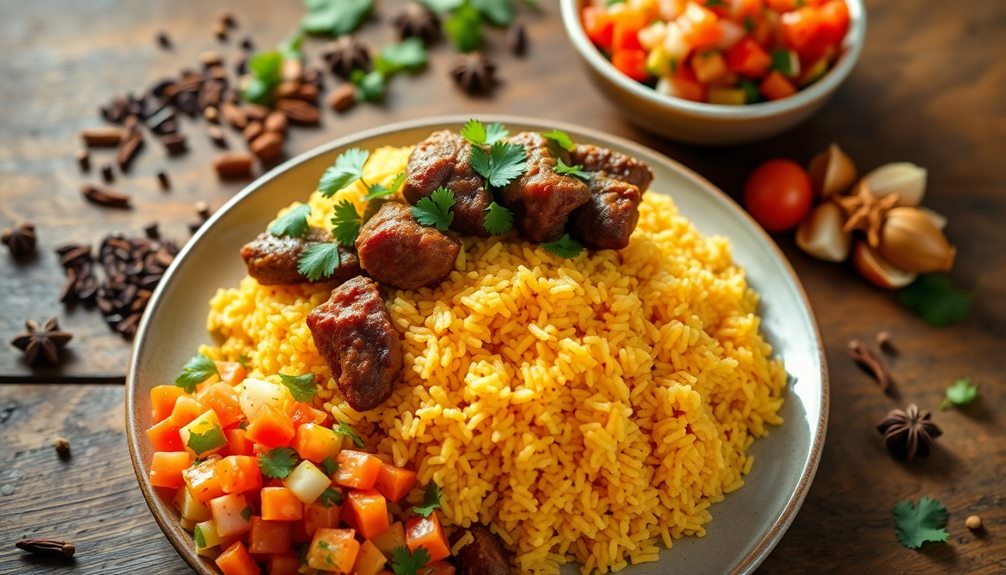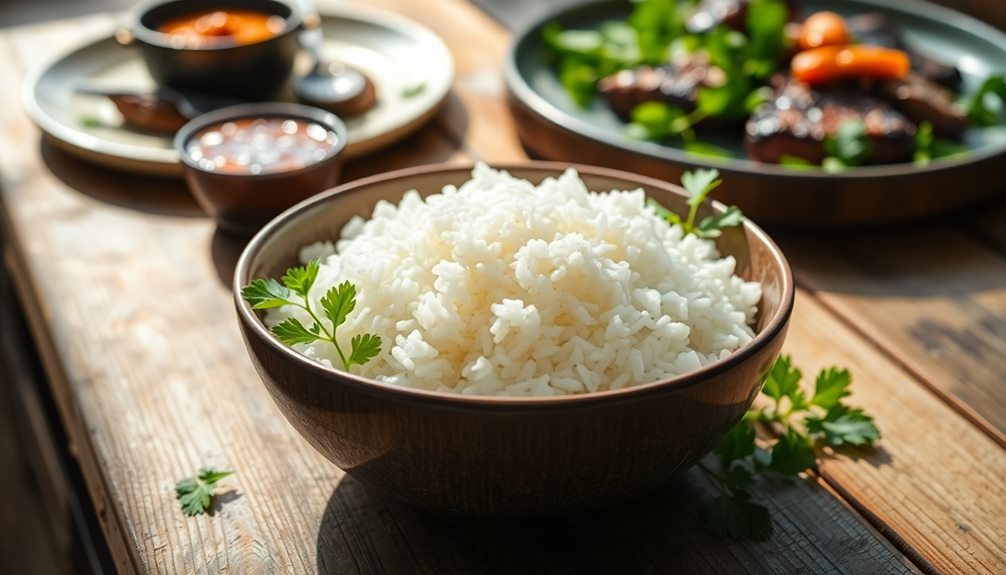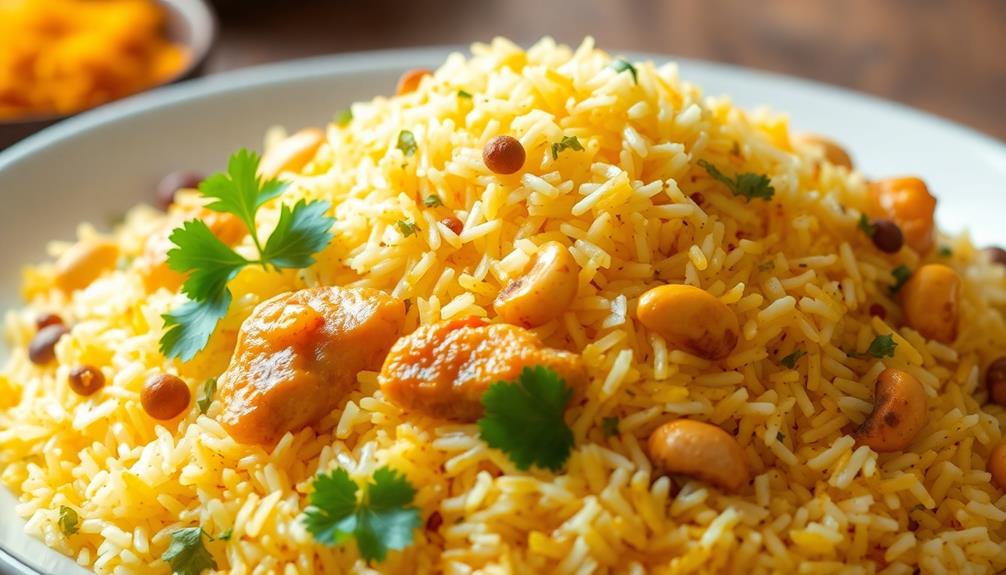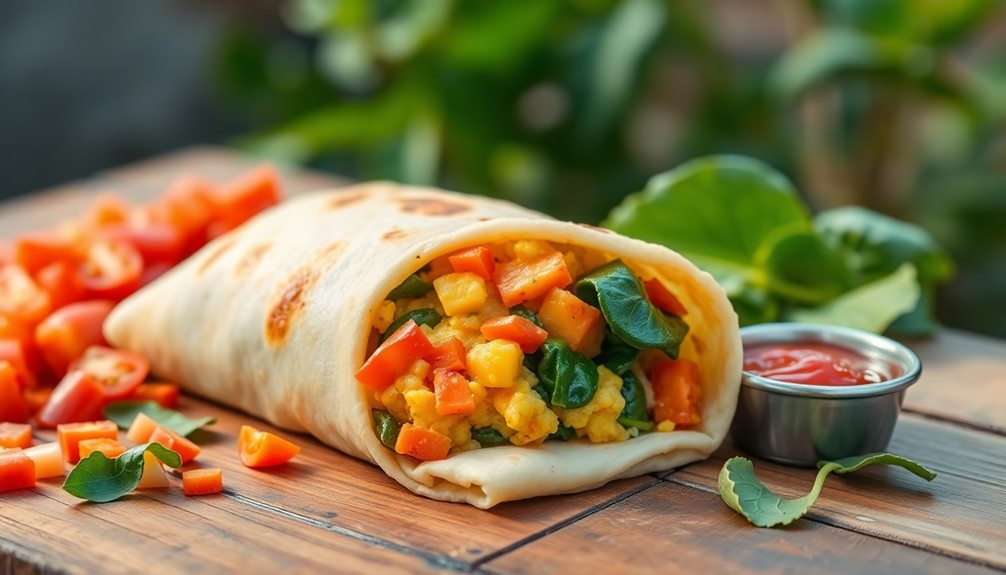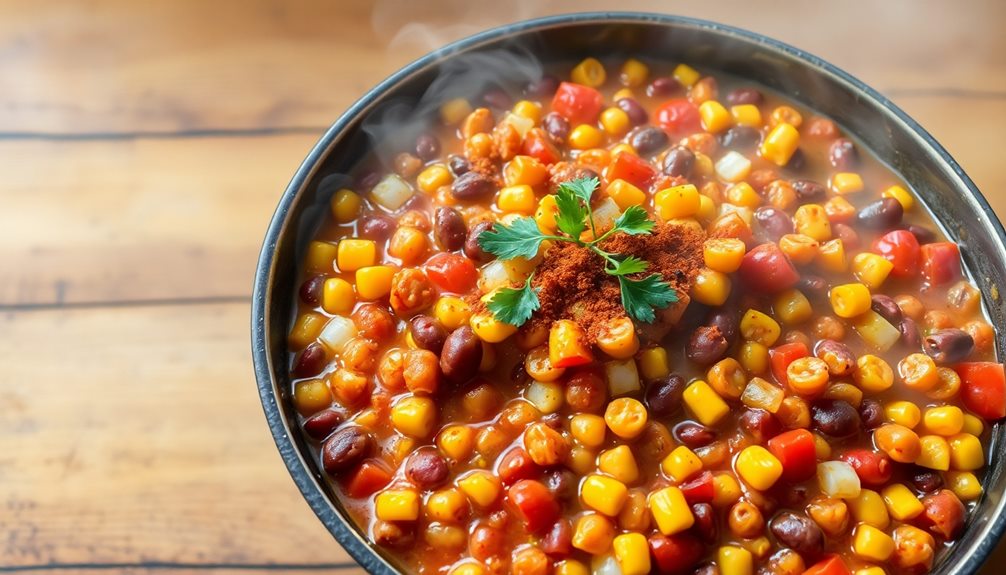Kenyan rice is a delicious adventure waiting for you! From flavorful pilau to creamy coconut rice, each bite tells a story of culture and tradition. When cooking, rinse the rice well to make it fluffy and soak it for extra tenderness. Spice it up with salt, cumin, and cardamom to create mouthwatering dishes. Simmer it until it's soft and then fluff it with a fork for the perfect texture. These meals bring families together, creating cherished memories. You'll surely find joy in exploring these tasty dishes and learning how to make them at home! More flavors and fun await!
Key Takeaways
- Kenyan rice has a rich history, becoming a staple food since its introduction in the early 1900s, especially in Mwea and Ahero regions.
- Popular rice dishes include pilau, coconut rice, biryani, fried rice, and plain boiled rice, each offering unique flavors and preparation methods.
- Cooking techniques such as rinsing, soaking, and simmering enhance the texture and taste of Kenyan rice dishes.
- Spices like cumin, turmeric, and cardamom are essential for developing the rich flavors characteristic of Kenyan rice recipes.
- Rice meals in Kenya symbolize community and cultural heritage, often shared during celebrations and family gatherings.
History
Although rice cultivation in Kenya has a relatively short history compared to other regions, it has rapidly evolved into an essential part of the country's agricultural landscape. You might be surprised to learn that rice was introduced to Kenya in the early 1900s. Since then, farmers have worked hard to adapt it to local conditions, making it a staple food for many families.
As you explore Kenya's diverse regions, you'll find that rice is grown in areas like Mwea and Ahero, where the climate and soil are just right. These farmers have learned to use clever techniques to grow rice efficiently, helping it become a crucial crop for the country.
Over the years, rice has woven itself into Kenyan culture, becoming a key ingredient in delicious dishes enjoyed during celebrations and family gatherings. From steaming bowls of plain rice to flavorful pilau, there's so much to discover!
As you dive into Kenyan cuisine, remember that rice isn't just food; it tells a story of hard work, innovation, and tradition. Each grain reflects the passion of farmers and the love of families sharing meals together.
Cooking Steps
Cooking Kenyan rice flavors requires attention to detail and a few key steps to achieve that perfect taste. First, you'll want to gather your ingredients. For dishes like Pilau, you'll need rice, spices like cumin and cardamom, and some vegetables or meat if you like.
Start by rinsing your rice under cold water until the water runs clear. This helps remove extra starch and keeps your rice fluffy.
Next, heat some oil in a pot and sauté your chosen spices and onions until they're golden and fragrant. Then, add your rice and stir it around to coat it in the tasty oil and spices. This step adds a lot of flavor!
After a minute or two, pour in enough water to cover the rice by about an inch. Bring it to a boil, then reduce the heat, cover the pot, and let it simmer.
Check the rice after about 20 minutes. If the water's absorbed and the rice is tender, it's ready! Fluff it up with a fork, and enjoy your delicious Kenyan rice!
You've just made a dish full of flavor and warmth that everyone will love!
Step 1. Rinse Rice Thoroughly Before Cooking
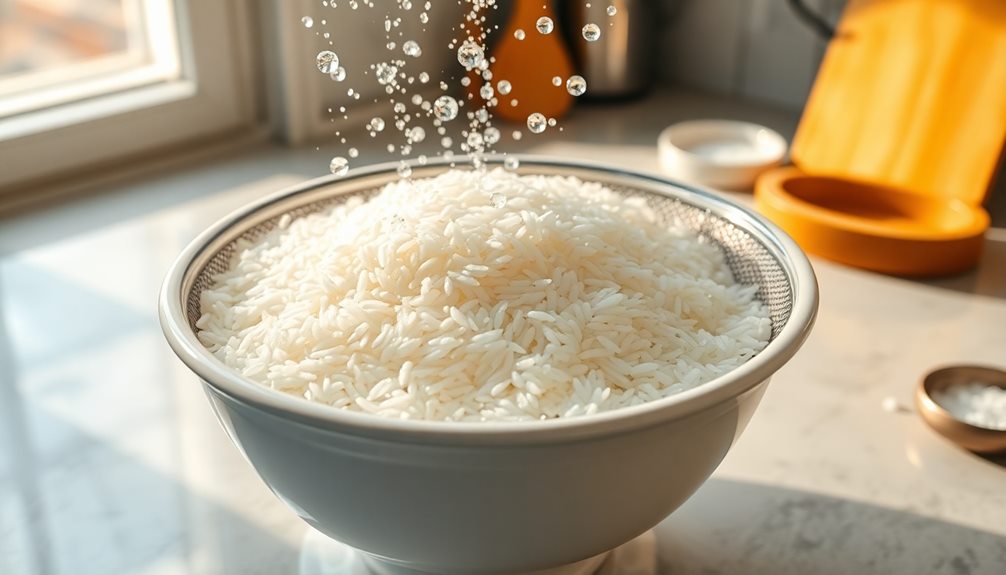
Rinsing your rice thoroughly before cooking is a crucial step that can significantly enhance its flavor and texture. When you rinse rice, you wash away excess starch that can make it sticky. Nobody wants a clumpy mess on their plate, right? Instead, rinsing helps each grain stay separate and fluffy, making your dish even better!
To rinse your rice, start by measuring out the amount you need. Place it in a fine-mesh strainer or a bowl. If you're using a bowl, fill it with cold water and swirl the rice around gently with your hand. You'll notice the water getting cloudy—that's the excess starch!
Pour out the cloudy water carefully, then repeat this process a couple of times until the water runs clear. This shows you've done a great job!
Once your rice is rinsed, let it drain for a minute. Now, you're ready to cook it! By taking this extra step, you'll bring out the best flavors and textures in your Kenyan rice dishes.
It's a simple trick that can make a big difference, so don't skip it! Enjoy your cooking adventure!
Step 2. Soak Rice for 30 Minutes
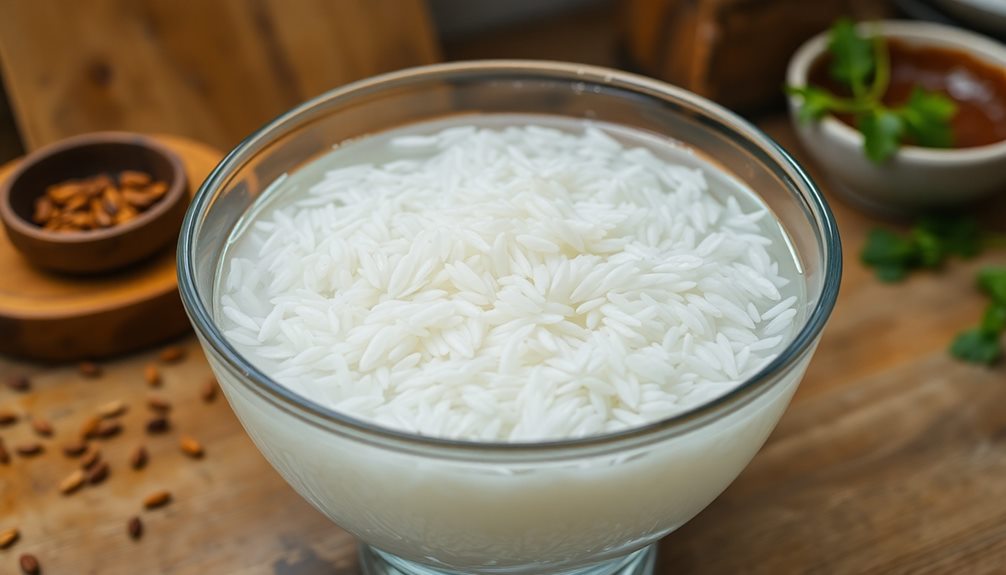
After rinsing your rice, soaking it for about 30 minutes can further improve its texture and cooking efficiency. Soaking helps the rice grains absorb water, making them softer and fluffier once cooked. This is especially important for dishes like pilau or coconut rice, where you want each grain to be perfectly tender.
To soak your rice, simply place it in a bowl and cover it with enough water to submerge the grains completely. You can stir it gently to make sure all the rice gets a chance to soak up the water. During this time, you can gather your other ingredients or prepare your cooking pot, which makes the process even smoother!
When the 30 minutes are up, you'll notice that the rice has expanded a bit. This is a good sign! Now, you can drain the soaking water and get ready to cook your rice.
Soaking not only saves cooking time but also helps the rice cook evenly, so every bite is delicious. You're one step closer to creating a fantastic Kenyan rice dish that everyone will love! Enjoy the process, and get excited for the tasty flavors to come!
Step 3. Add Spices for Flavor
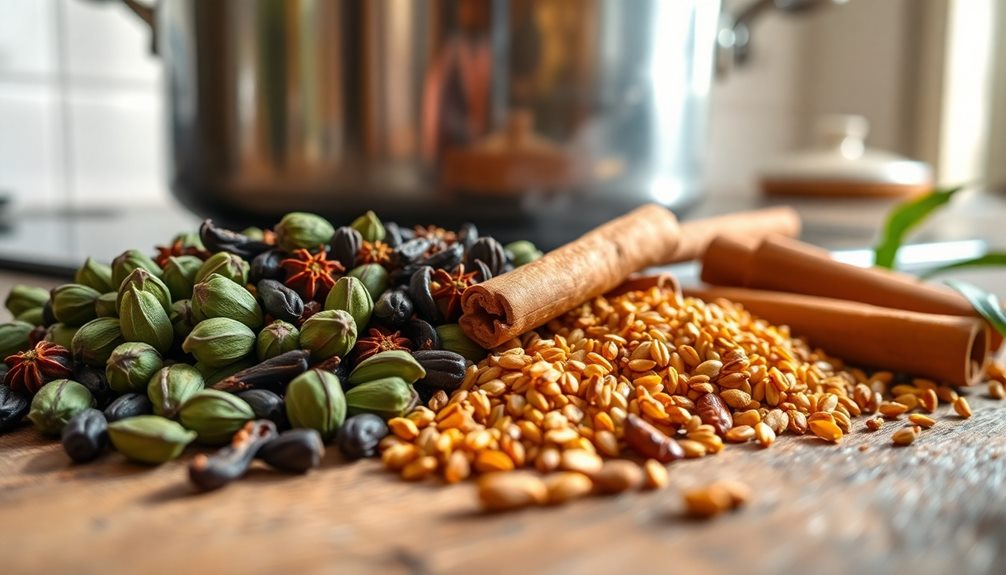
Spices are the heart of Kenyan rice dishes, transforming simple grains into a flavorful experience. When you're ready to add some zest, gather your spices! Start with a bit of salt to enhance the flavors.
Then, think about using some turmeric for a lovely golden color and a warm taste. Don't forget the cumin; it adds a special earthiness that makes your rice feel cozy. To elevate your cooking, consider checking out specialized tools like herbal infusion machines that can enhance your flavor profiles.
Next, consider adding some black pepper for a little kick! If you want to experiment, throw in some cardamom or cinnamon, too. These spices create a delicious aroma that will have everyone asking for seconds. You might even want to add a pinch of chili powder if you enjoy a bit of heat.
As you mix in these spices, remember to stir well! This step helps distribute the flavors evenly throughout the rice. You're building layers of taste that will make each bite delightful.
Feel free to get creative and adjust the amounts to match your preferences. Cooking should be fun, so let your taste buds guide you! Enjoy the magic of spices, and get ready for your delicious Kenyan rice adventure!
Step 4. Simmer Until Tender
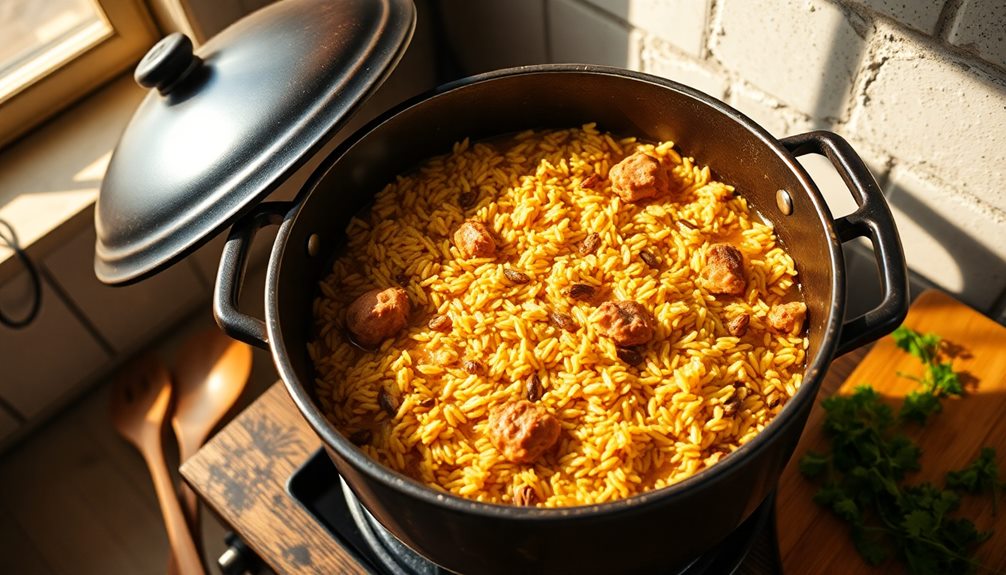
Once you've added your spices and stirred them into the rice, it's time to start the cooking process. Grab a pot and pour in enough water to cover the rice by about an inch. This'll help the rice cook evenly.
Now, turn up the heat and bring that water to a boil. Once it's bubbling, reduce the heat to low and put a lid on your pot.
Let it simmer gently for about 15 to 20 minutes. This is where the magic happens! Keep an eye on it, and don't forget to check if the water has evaporated. You want the rice to soak up all those delicious flavors from the spices you added earlier.
If the rice isn't quite tender yet and there's still some water left, just give it a few more minutes.
When the rice is soft and fluffy, you'll know it's ready. The aroma will fill your kitchen, making your mouth water!
Step 5. Fluff Rice With Fork

The satisfaction of a perfectly cooked pot of rice comes together when you fluff it with a fork. After simmering your rice until it's tender, let it sit for about five minutes with the lid on. This resting time helps the grains absorb any leftover steam, making them even fluffier.
Now, grab a fork and gently lift the rice. Start at the edges, and work your way to the center. You want to separate the grains without smashing them. Fluffing helps release any steam trapped inside, giving your rice that light, airy texture that's so enjoyable.
As you fluff, you might notice the delightful aroma wafting up. Isn't that amazing?
Your rice should look inviting and ready to be served alongside your favorite Kenyan dishes, like pilau or coconut rice.
Final Thoughts
Ultimately, you'll find that Kenyan rice offers a unique culinary experience that reflects the country's rich agricultural heritage. From the spicy, aromatic pilau to the creamy coconut rice, each dish tells a story of tradition and culture. You can almost taste the sunshine in every bite!
When you prepare these dishes, remember to embrace the flavors and spices. Don't be afraid to experiment a little. Adding your favorite ingredients can make the meals even more delicious. Imagine cooking up a warm bowl of rice, filling your kitchen with delightful aromas that make your family gather around the table.
Kenyan rice isn't just food; it's a way to connect with friends and family. Think about sharing a meal with loved ones, laughing, and creating memories. You might even find that trying out these recipes sparks your own creativity in the kitchen!
Frequently Asked Questions
What Types of Rice Are Commonly Used in Kenyan Dishes?
You'll find various types of rice in Kenyan dishes, like Basmati, which is popular for pilau, and long-grain rice, often used in everyday meals. Jasmine rice also makes appearances, adding unique flavors to traditional recipes.
Are There Vegetarian Options for Kenyan Rice Recipes?
Yes, there are plenty of vegetarian options for Kenyan rice recipes. You can try dishes like rice pilau, coconut rice, or vegetable fried rice, all packed with flavors and made using fresh, local ingredients.
How Can I Store Leftover Kenyan Rice Dishes?
To store leftover rice dishes, let them cool completely, then transfer to airtight containers. Refrigerate for up to four days or freeze for longer storage. Reheat thoroughly before enjoying again. Don't forget to check for freshness!
What Are Traditional Accompaniments for Kenyan Rice Meals?
When enjoying Kenyan rice meals, you'll often find accompaniments like spicy stews, grilled meats, or fresh vegetables. Don't forget the tangy kachumbari salad; it adds a refreshing crunch that perfectly complements the rice's flavors.
Can Kenyan Rice Recipes Be Adapted for Dietary Restrictions?
Absolutely, you can adapt Kenyan rice recipes for dietary restrictions. Substitute ingredients, like using vegetable broth instead of meat, or opting for gluten-free grains. With creativity, you'll enjoy delicious meals that fit your needs.
